#1st century B.C. painting
Explore tagged Tumblr posts
Text

Wall painting on black ground - Aedicula with small landscape, from the imperial villa at Boscotrecase (1st century B.C.)
335 notes
·
View notes
Text
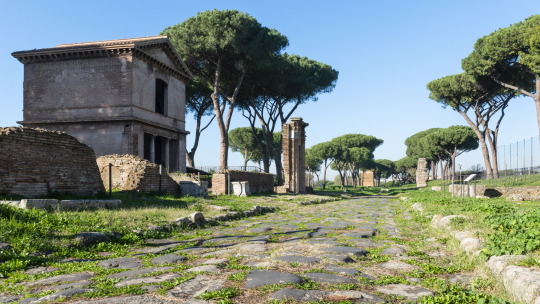
Antigua Via Latina / The ancient Via Latina
In the middle of the Roman periphery, between the modern Via Appia and Via Tuscolana, a section of the 3rd mile of the ancient Via Latina is preserved in perfect condition.
It has ancient origins: the natural route, already followed in prehistoric times, was used by the Etruscans to colonise Campania in the 8th-6th centuries BC.
Definitely laid out by the Romans around the IV-III centuries B.C., it connected Rome with Capua, maintaining its importance throughout Antiquity. In fact, even in the Middle Ages, it was preferred as an access road to Naples because of its better preservation compared to the Appian Way and the presence of a number of Christian places of worship along the route..
Entering the Archaeological Park of the Tombs of the Via Latina, it is now possible to walk along a section of the original paving of the street. With a pleasant walk you can admire the rich tombs dating back to the I-II century A.D. that overlooked the route, which still have perfectly preserved polychrome decorations on the façades and inside: vaults covered with painted plaster and stucco, walls frescoed with funerary scenes and rich mosaic floors are still substantially intact in their original context.
From the street it is also possible to reach the Basilica of S. Stefano, a rare example of an early Christian building erected under the pontificate of Leo the Great in the middle of the 5th century.
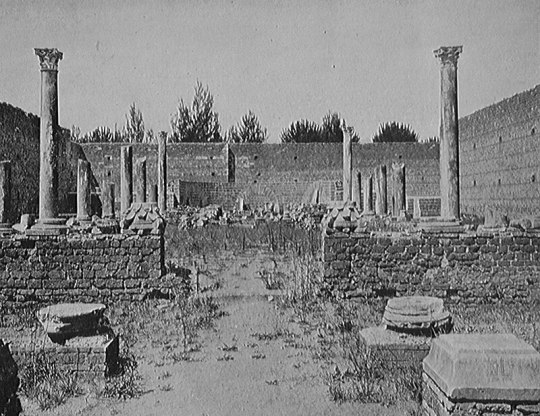
Santo Stefano en Vía Latina, restos parcialmente reconstruidos, 1911.
Santo Stefano in Via Latina, partially reconstructed remains, 1911.
The Archaeological Park of the Tombs of the Via Latina was created in 1879 following the acquisition by the State of a vast area in which important remains from Roman times had been discovered.
BARBERINI TOMB
The so-called Barberini Sepulchre, or Sepulchre of the Corneli. The funerary monument, dating from the 2nd century AD, consists of two above-ground floors and a hypogeum in an excellent state of preservation. The upper floor is covered by a ribbed vault completely covered with plaster painted with a red background and stucco elements. Groups of figures, winged victories on chariots, love affairs, birds, marine animals, mythological themes and architectural backgrounds can be recognised.

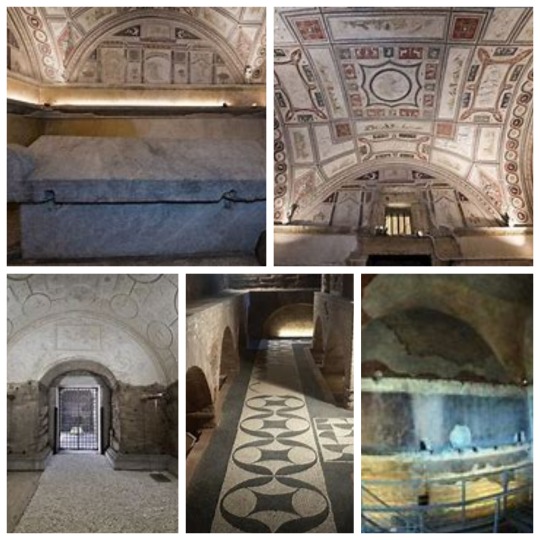
Sepulcro Barberini y su interior / Barberini Tomb and its interior
TOMB OF THE VALERI
The Tomb of the Valeri. The richly decorated underground rooms dating from the mid-2nd century AD are preserved, while the elevation is a hypothetical reconstruction dating from the mid-19th century. An elaborate white stucco covering, articulated in 35 medallions and panels, adorns the lunettes and the barrel vault of the underground room. The medallions depict Dionysian themes, female figures and sea animals, while in the central tondo there is a delicate-veiled figure on the back of a griffin, representing the deceased being carried to the afterlife.
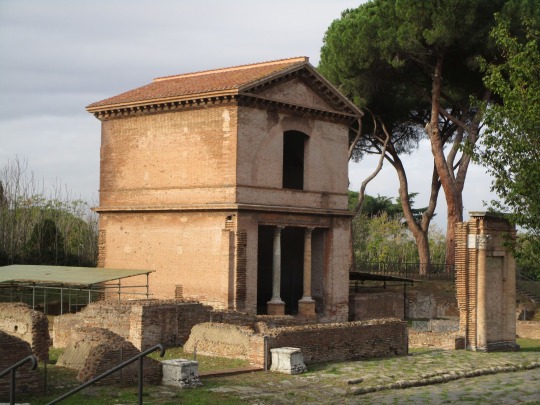
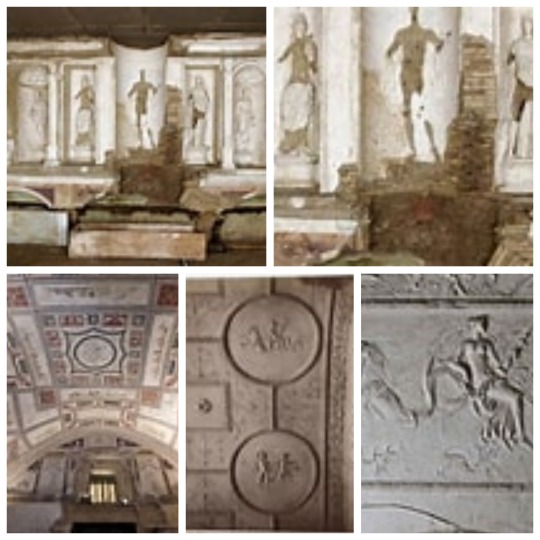
Tumba de los Valeri, exterior e interior / Tomb of the Valeri, exterior and interior
THE TOMB OF THE PANCRATII
The Tomb of the Pancratii. Much of the visible structure is a modern construction that protects the monument below by resting on the original 1st-2nd century AD walls, about a metre high. Upon entering the tomb, one can admire the beautifully decorated underground rooms, with mosaics on the floors and vaults and walls frescoed in bright colours and stucco in an excellent state of preservation. They depict mythological scenes, natural and architectural landscapes, images of women and animals. In the centre of one of the underground chambers is a large sarcophagus for two Greek marble depositions.
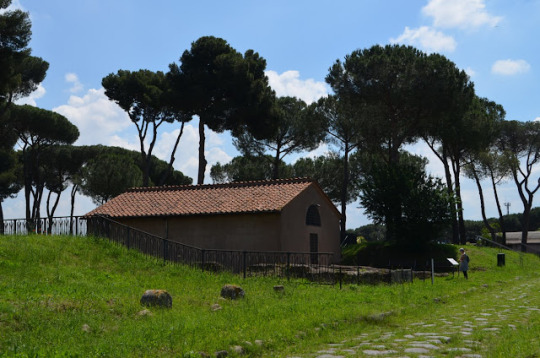

Sepulcro de los Pancracios, exterior e interior / Tomb of the Pancracios, exterior and interior
84 notes
·
View notes
Text
Ergo Proxy References and Parallelisms Vol. II
Hello there and welcome back to the Compilation of Ergo Proxy's references and parallelisms with other forms of art Literature, Cinema and Music. On this volume I'll attempt to expand on other parallels between this anime and other classical works of culture.
Some interpretations here will be highly speculative, and whether the connections were intentional or no, it's not entirely clear in every case.
Further updating and editing will come soon as part of the maintenance o this post.
As always, thank you for reading.
VOLUME II:
- Meditatio XI In the White Darkness - City Lights Bookstore - Les mémoires d'un saint - Apollo et Artemis - Ophelia - 2001 Space Odyssey - Amrita - Blade Runner - Eine Klein Nacht - A Minoan Tragedy
In the White Darkness

Meditatio XI is titled just like the interactive multimedia poem created by Reiner Strasser in collaboration with M.D. Coverley (Marjorie Coverley Luesebrink) over a 9-month period in 2003-2004. Just like the episode is an exploration on the nature between the self and the memories, and the recollection (anamnesis) of Vincent's Experieces, this visual poem explores the nature of memory, particularly focusing on the experiences of individuals with Alzheimer's or Parkinson's diseases.
"ii — in the white darkness" was originally published in January 2004 on Strasser's website. It has been preserved using Ruffle by the Electronic Literature Lab in February 2021, ensuring its continued accessibility (LINK).
Note: This is my favorite episode of the serie, so, perhaps I'll dedicate it a disproportionately long dive in, when compared to the other episodes.
CITY LIGHTS BOOKSTORE
City Lights Booksellers & Publishers was established in 1953 by poet Lawrence Ferlinghetti and Peter D. Martin, and is an independent bookstore and publishing house located in San Francisco, California. Renowned for its commitment to world literature, the arts, and progressive politics

On the series, is the (mental) place that Vincent visits while he is lost on Meditatio XI.
Perhaps a sort of involuntary Mental Palace for his knowledge to be guarded. But, this time, He is lost, and the books are empty.
Les mémoires d'un saint
This one I don't feel is an intentional example, but I believe is worth mentioning.
The Memoirs of a Saint is a 1960 painting made by the french René Magritte, that features a stage-like setting with three monumental curtains, the central one filled with an image of a cloudy sky, creating this self contained contradiction between the interior and exterior, alluding perhaps to the internal contemplative stage of the mind.
This introspective exercise is actually the core of Meditatio XI and as so, is echoed over and over again as Vincent Law unravel his own persona to uncover Ergo Proxy as his concealed identity, buried in his unconscious as the product of a self-inflicted amnesia.


Yet another layer of the Blue Sky Theatre is the revelation that of the Deus Ex Machina in the homonymous Meditatio XXIII, on which even Ergo Proxy is revealed as a fabrication of the vengeful Proxy One, who sits under the representation of a blue sky (The same beams of light foreshadowed on the Proxy's Mind Theater are actually the cause of the demise of Proxy One). And with that the oneness of the individual is reconstructed and the discernment between outside and inside is disolved.


MEDITATIO XXIII: DEUS EX MACHINA
EXTRA: A quote
JJ (JJ本屋) quotes James Alonzo Bishop
"the future is an opaque mirror. Anyone who tries to look into it sees nothing but the dim outlines of an old and worried face." Jim Bishop, New York Journal-American, March 14, 1959
APOLO and ARTEMIS... and Heraclitus
On the Library there are two marble statues:


Apollo Belvedere
A 2nd century A.D. Roman copy of an original bronze statue created between 330 and 320 B.C. by the Greek sculptor Leochares.
and

Diana of Versailles
Another partially restored Roman copy (1st or 2nd century CE) of a lost Greek bronze original attributed to Leochares, c. 325 BCE.
The "Logos" or "meaning" behind this peculiar choice of symbols requires the conciliation of opposites through the interplay of meanings and the tension of words.
Artemis and Apollo, as twin deities from Greek mythology, are rich with symbolic meaning, representing complementary dualities and a harmonious balance of opposites.
Artemis is often associated with the moon, symbolizing intuition, mystery, and the subconscious. As a huntress her instrument is the bow.
Apollo represents the sun, symbolizing clarity, superego, reason, and illumination. His light drives away shadows, suggesting knowledge triumphing over ignorance. As a musician his instrument is the lyre.
The pulsation of a string in one is a weapon, an instrument of death, and on the other is the product of the death of an animal, but an instrument of joy. Is interesting to notice that in a polysemic sense the greek word bios can express the nuances behind the symbology conveyed on this Meditatio. Biós (βιός with the accent on the O) is the Greek for "bow". Bίοs (βίος with the accent on the I), is the Greek for "life". The Greek philosopher Heraclitus was aware of this conception and used them to express his dialectical views of nature. for him, and through him, other philosophers and thinkers did too:
"The bow's name is life, but its work is death." [source]
On the same way, the secondary creator, Ergo Proxy, builder of Romdeau, is the "Agent of Death".
The irony is that the very Title of this Meditatio, "In the White Darkness", exposes this internal but revealing contradiction.
Following the previously exposed is worth noting that the solar and lunar duality of those greek deities was a motif that also appeared on previous episodes in the shape of Senekis and Kaskis, the lover proxies from the double dome of Charos and Asura. The love between them, and the compulsive strife of their forces to annihilate mutually (enabled by the Pulse o the Awakening) gave them purpose and meaning, and motivated the absurd state of war among their respective citizens. The decaying halves of a same dome was on an insatiable conflict between parts de-voided of all human-like traits: The Knights droids vs the soldiers of the last War Battalion.
In the own psychological world of Vincent/Ergo, the amnesiac dissociation of his persona that fractured the interplay between anima and animus, between his two halves, can only be resolved by the integration and recognition of himself as a whole.
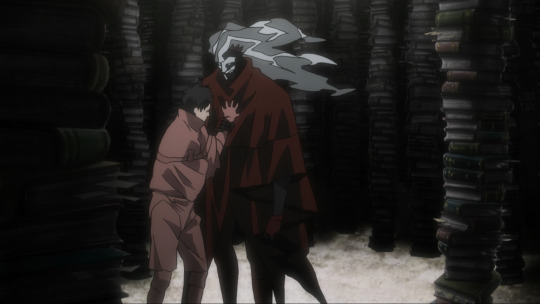
I think, therefore I am. I think therefore you are I am you. You are me
Ophelia

Ophelia is the title of the Meditatio XIV. On this episode, the protagonists arrive at an abandoned dome named Ophelia, with a mall of the same name to replenish their supplies. Unbeknownst to them, the dome's Proxy, capable of shape-shifting, subjects them to a series of illusions, delving into their psyches.
On the episode there is another obvious reference to Shakespeare's Ophelia

This is a direct nod to the Ophelia, as depicted by Sir John Everett Millais on a painting made on 1821.

2001 Space Odyssey
On the Show of Meditatio XV, some visual references to the classic film can be drawn. For Example the reference to the use of tools as bones, and the parallels between this first and last tool:



The Boomerang Star
AMRITA

As stated on the show, the biological material that forms the proxies it's called Amrita, a sanskrit term (अमृत) analogous to the greek amaranthos (ἀμάραντος) that means "immortal", "never-dying". It is a central concept within Indian religions and is often referred to in ancient Indian texts as an elixir, is comparable to the ambrosia of the greeks that also was related to the inmortality.
Amrita Cells lacks a Hayflick Limit (the he number of times a normal somatic, differentiated human cell population will divide before cell division stops) and so, they are essentially able to regenerate endlessly.
Blade Runner Death
Both Amnesia and Dr Eldon Tyrell from Blade Runner are blinded and killed by the same way: eye crushing. Dr Eldon Tyrell is the creator of the Nexus-6 Models on Blade Runner. Amnesia is the guardian of the memories of Mosko Dome, and stores the memories of Ergo Proxy.


EINE KLEINE NACHTMUSIC
On Meditatio XX, when Dedalous, Re-L and Swan are dinning, the classical piece playing is the second movement of Eine kleine Nachtmusik in G Major, K. 525, Romanza, quite popular for appearing on Alien The Eight Passenger.

A Minoan Tragedy (Kind of...)
Daedalus Yumeno (デダルス・ユメノ) is quite and interesting choice for the name of the Welfare Bureau. Both characters are brilliant on their fields and the bold approaches they apply to their schemes.
Deep is their hubris too, and their desire to shape the world to their whims. Both the mythological character and his anime homonym defy the natural order and provide the aid with the genetic experimentation. The first is the responsible of aiding Pasiphae to get pregnant by the White Bull (act that created the hybrid now called The Minotaur), and the second one is responsible for the cloning of Re-L Mayer and the hybridization between a Re-l and Monad Proxy. Also it's the mind behind the attempt of make the inhabitants of Romdeau able to reproduce again.
Beyond the name, that, Daedalus Yumeno is also surrounded by minor minoan references, as this dolphin on his holographic aquarium that comes straight from the early minoan paintings on the Crete Palace.

And there's also... The Thread

On greek myths, Daedalus provides the princess Ariadna with a ball of thread to help Theseus to navegate the Labyrinth. On the other hand Daedalus Yumeno gave REAL/Monad a ball of red thread for her to make easier to find her.
Eventually, on Meditatio XXIII, REAL/Monad takes the role both of Icarus and of Ariadne, but Daedalus Yumeno don't stand her abandoning him (again) for Vincent Law/Ergo Proxy, and destroys the Dome.

Ergo Proxy (our Theseus) then confronts his original, Proxy One (The Minotaur), and it's brought out of the crumbling dome by the now Winged ReaL/Monad.

But as most proxies, ReaL/Monad has a fatal weakness on her design, she is vulnerable to the sunlight and the UV rays. Thus, despite the warnings of Daedalus when she attempted to fly to close to the sun, she dies disintegrated, just as when Icarus tries to fly too high and close to the sun, his wax wings melts and he falls into the ocean.
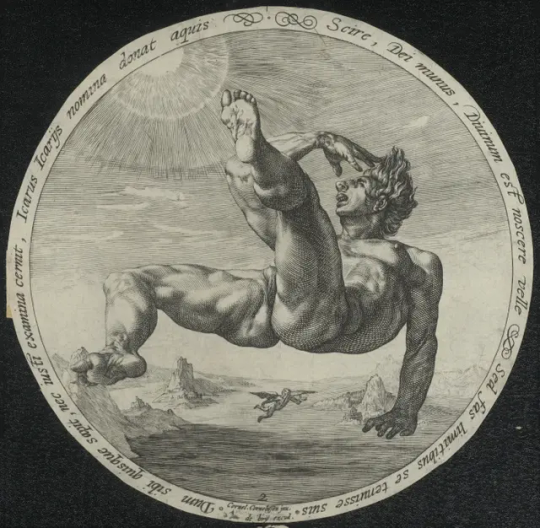
Fall of Icarus, ca. 1588 from a series of The Four Disgracers. Engraving by Hendrick Goltzius
9 notes
·
View notes
Text
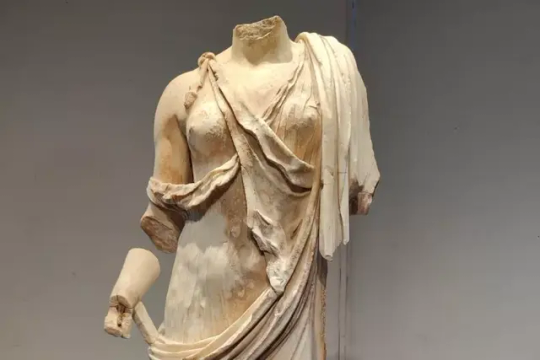
Archaeologists Discover 'Exceptional' 2,000-Year-Old Female Marble Statue
An "exceptional" marble statue from the Roman era has been discovered in Italy, researchers have announced.
The statue dates to around 2,000 years ago—somewhere between the middle of the 1st century B.C. and the mid-1st century A.D.
Researchers from the Spanish School of History and Archaeology of Rome (EEHAR)—part the Spanish National Research Council (CSIC)—located the statue, which depicts a female figure, during excavations at the archaeological site of Tusculum.
The ancient city is located in an area known as the Alban Hills, which lies on the outskirts of Rome. In ancient times, this area—known for its luxurious villas and country houses—was often used by the rich as an escape from the capital.
The life-sized statue is in excellent condition and of high quality, although it is missing the head and parts of the arms, according to the researchers. It probably once belonged to an ancient bathhouse in the city.
"This is an exceptional discovery. At the time of discovery, only part of the statue's back was visible and it was lying on a thin layer of painted stucco, so it would be part of the ornamental program of the thermal baths," EEHAR director Antonio Pizzo said in a press release.
Some characteristics of the statue have led researchers to conclude that it may have been linked to the cult of the god Dionysus. For example, the statue features a depiction of a fawn skin that the followers of the god's cult wore.
Dionysus, also known as Bacchus, was a Greco-Roman god of wine, fruit, vegetation, fertility, ritual madness and ecstasy, among other traits.
By ARISTOS GEORGIOU.
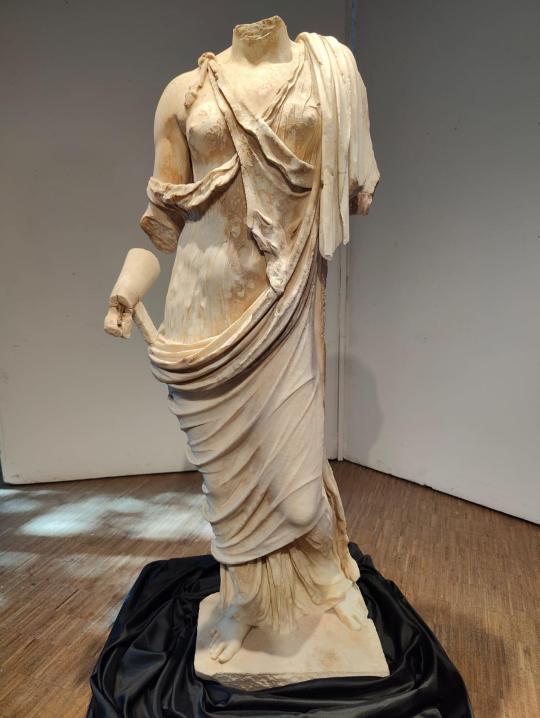
#Archaeologists Discover 'Exceptional' 2000-Year-Old Female Marble Statue#Tusculum#Alban Hills#the god Dionysus#marble#marble statue#roman marble statue#ancient artifacts#archeology#archeolgst#history#history news#ancient history#ancient culture#ancient civilizations#roman history#roman empire#roman art
50 notes
·
View notes
Text
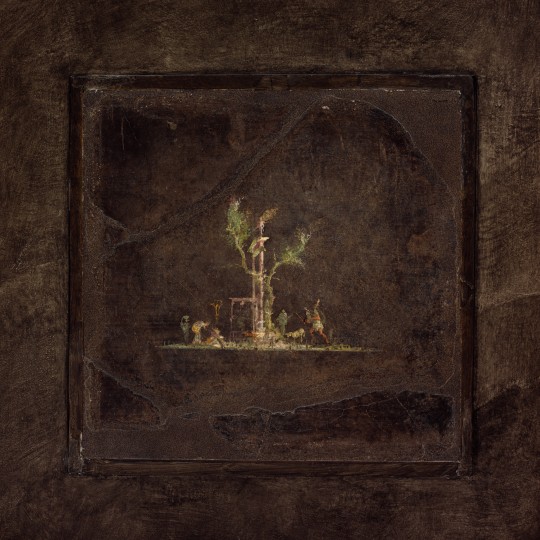
Wall painting on black ground: landscape, from the imperial villa at Boscotrecase. Roman, Pompeian last decade of the 1st century BCE. x
Many private summer villas were located along the coast near Naples. One of the most sumptuous must have been the villa built by Agrippa, friend of the emperor Augustus and husband of his daughter, Julia. It stood overlooking the Bay of Naples from a spot near the modern town of Boscotrecase. The villa was partially excavated between 1903 and 1905 after its accidental discovery during work on a railway. Wall decorations that still survived in four bedrooms were removed. The Metropolitan Museum acquired sections from three rooms and the Archaeological Museum at Naples received the rest.
Agrippa died in 12 B.C. and his son, Agrippa Postumus became the villa's proprietor in 11 B.C. as inscriptions found there indicate. The frescoes must have been painted during renovations begun at the time. Painted by artists working for the imperial household, they are among the finest existing examples of Roman wall painting.
The so-called Black Room was one of a sequence of bedrooms facing south toward the downward slope of the mountain and the sea. The source of light was a wide doorway giving onto a terrace or promenade.
This ambiguous and sophisticated decoration is a masterpiece of the so-called third style of Roman wall painting, which flourished during the reign of Augustus. The theme is a playful rendition of architectural motif. A low red dado serves as the base from which a skeleton of thin white columns appears to rise against a black background. There almost weightless columns support pavilions, candelabra, tripods, and a narrow cornice that runs around the room. They were embellished with jewel-like decorations. On the back wall tiny swans, the bird of Apollo, patron god of Augustus, perch improbably on threadlike spirals, and yellow panels with Egyptianizing motifs must have brought to mind the recent annexation of Egypt after the death of Cleopatra in 30 B.C. This architectural scheme creates almost no sense of depth or volume. The black walls behind appear at once to be flat and to dissolve into limitless space. Tiny landscape vignettes float like islands in the middle of this blackness. Burnished to a high polish, these walls must have appeared magical indeed when illuminated by lamps at night.
50 notes
·
View notes
Text
On the descent of Cleopatra VII
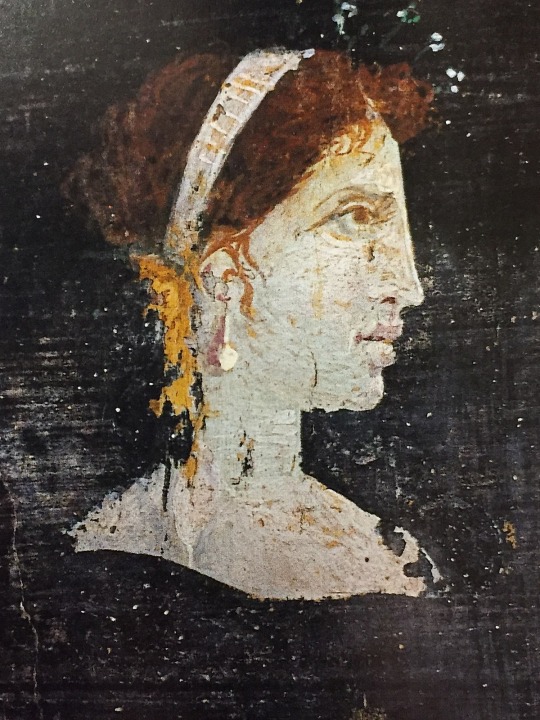
(Posthumous painted portrait of Cleopatra VII of Egypt, from Herculaneum, Italy)

(An ancient Roman bust of Cleopatra VII of Ptolemaic Egypt, from the Archaeological Museum of Cherchel, Algeria)
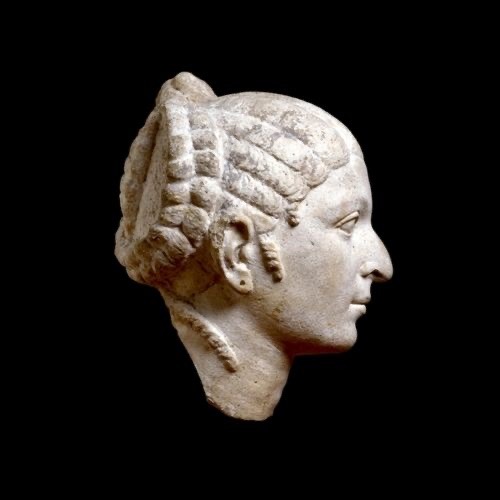
(Limestone Head of a Woman Resembling Cleopatra VII
Roman, about 50-30 BC
Acquired in Italy
The British Museum, Located in Room 70: Roman Empire)
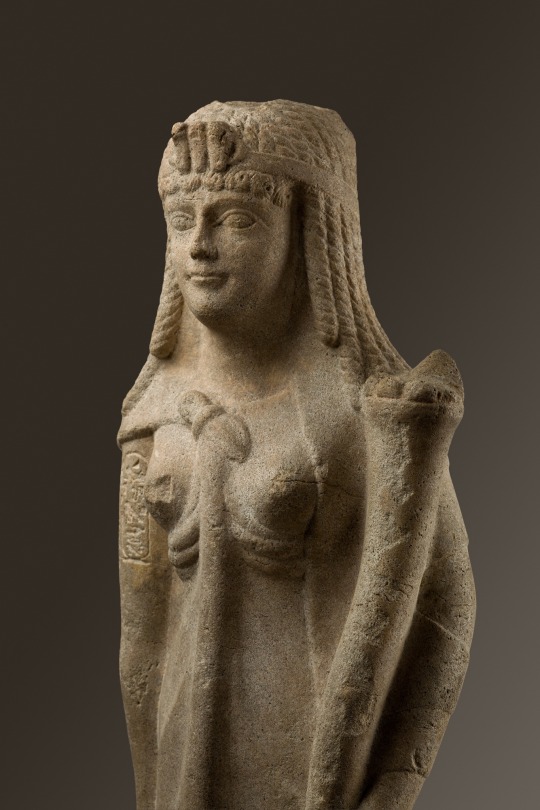
(Statue of a Ptolemaic Queen, perhaps Cleopatra VII
Ptolemaic Period
200–30 B.C.
On view at The Met Fifth Avenue in Gallery 134)
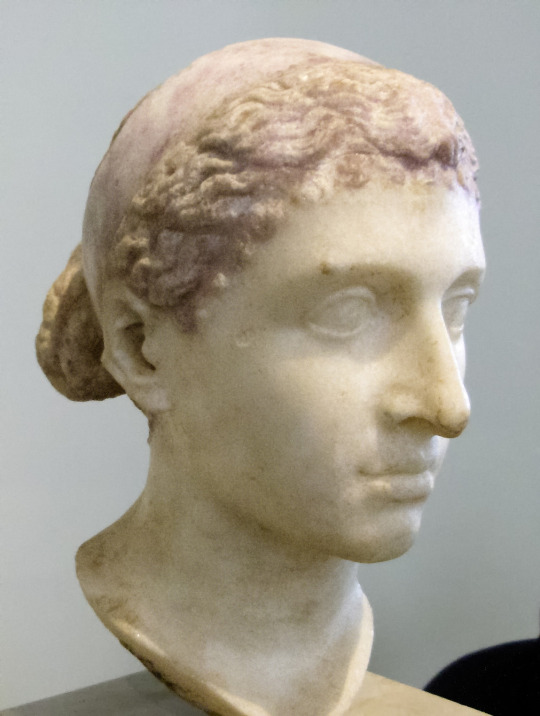
(The Berlin Cleopatra, a Roman sculpture of Cleopatra wearing a royal diadem, mid-1st century BC (around the time of her visits to Rome in 46–44 BC), discovered in an Italian villa along the Via Appia and now located in the Altes Museum in Germany.)
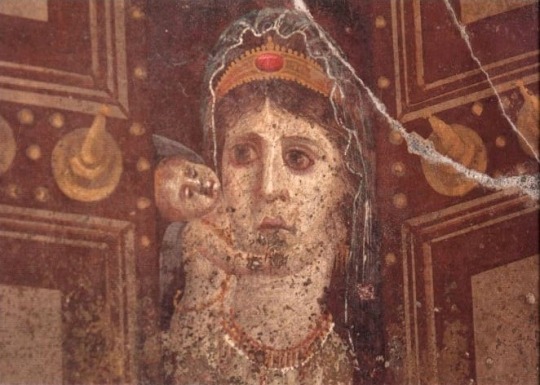
(This mid-1st Century BCE mural portrays a statue of Venus and the infant Cupid in the Temple of Venus Genitrix, Rome. The statue has been identified as the infamous gilded statue of Cleopatra VII as Venus that Julius Caesar unveiled during the temple's dedication in 46 BCE)
“The Ptolemaic Dynasty controlled Egypt for almost three centuries (305 – 30 BCE), eventually falling to the Romans. Oddly, while they ruled Egypt, they never became Egyptian. Instead, they isolated themselves in the capital city of Alexandria, a city envisioned by Alexander the Great. The city was Greek both in language and practice. There were no marriages with outsiders; brother married sister or uncle married niece. The last Ptolemaic queen, Cleopatra VII (l. c. 69-30 BCE), remained Macedonian but spoke Egyptian as well as other languages. Except for the first two Ptolemaic pharaohs, Ptolemy I and his son Ptolemy II, most of the family was fairly inept and, in the end, only maintained authority with the assistance of Rome.
A Greek Family of Egyptian Pharaohs
One of the unique and often misunderstood aspects of the Ptolemaic dynasty is how and why it never became Egyptian. The Ptolemys coexisted as both Egyptian pharaohs as well as Greek monarchs. In every respect they remained completely Greek, both in their language and traditions. This unique characteristic was maintained through intermarriage; most often these marriages were either between brother and sister or even uncle and niece. This inbreeding was intended to stabilize the family; wealth and power were consolidated.”
( from https://www.worldhistory.org/Ptolemaic_Dynasty/ )
#the descent of cleopatra vii#cleopatra vii#history lesson#cleopatra vii lineage#cleopatra#cleopatra vii ancestry#ptolemaic dynasty#egyptian history
16 notes
·
View notes
Text
Romano-Egyptian cartonnage mummy mask depicting a female head
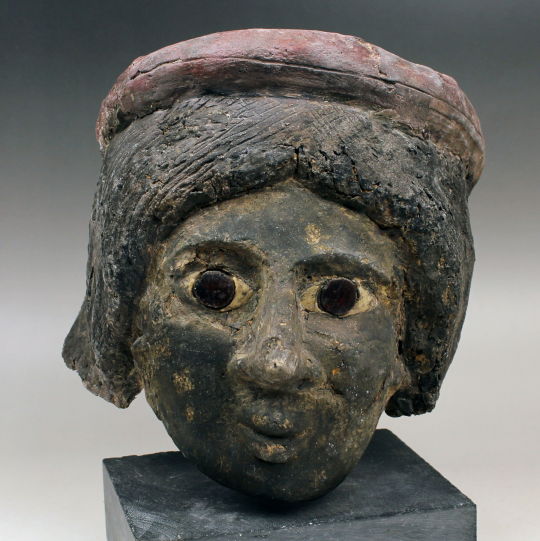
ITEM Romano-Egyptian cartonnage mummy mask depicting a female head MATERIAL Linen and Gesso CULTURE Egyptian, Roman period PERIOD 1st Century B.C – 1st Century A.D DIMENSIONS 208 mm x 200 mm x 200 mm (without stand) CONDITION Good condition PROVENANCE Ex English private collection, Ex Christie’s, London, April 2000, lot 59 (part lot), Ex Belgian private collection, Ex Bonhams During the Roman period in Egypt, which spanned from the 1st century BCE to the 4th century CE, a unique blend of Egyptian and Greco-Roman artistic influences emerged. This period saw the production of cartonnage mummy masks that often depicted female heads, showcasing a fusion of traditional Egyptian religious beliefs with the cultural impact of the Roman Empire. Cartonnage was a material made from layers of linen or papyrus soaked in plaster, creating a rigid surface suitable for painting and decoration. The female heads depicted on these mummy masks during the Roman period often reflected the idealized beauty standards of the time. These masks were not just functional elements for preserving the deceased's features, but also served a ritualistic and symbolic purpose. The depictions frequently incorporated Roman hairstyles and fashion trends, showcasing the blending of cultural elements. Read the full article
#ancient#ancientart#ancienthistory#artefact#artifact#ancientartifacts#antiquities#antiquity#art#artobject#ancientrome#ancientworld#history#classical#archaeology#roman#egyptian#romano-egyptian#mummy#sarcophagus#female#head#cartonnage
2 notes
·
View notes
Text
Discovery of Mesolithic rock paintings
D. Ravinder Reddy and Dr. Muralidhar Reddy have discovered Mesolithic rock paintings in Seetamma Loddy, Telangana.Seethamma Loddy is located at Gattusingaram in Peddapalli district.The rock paintings found here belong to the Mesolithic period (10,000-12,000 years ago) and the early historic period (1st BC to 6th century). They were found on a large sandstone rock in the forest.A fossil stone containing shells has also been found which suggests that the site is approximately 65 million years old.Dr. Muralidhar Reddy has described the site as a “diamond mine” of rock paintings, like Pandavula Gutta located in Jayashankar Bhupalapalli district. Pictures found on rock paintings - There are depictions of human figures on it. - Both men and women are performing group dance in line and round patterns. - Everyone is holding each other's hands and wearing special types of shoes. - A picture of a person with a bow and arrow has been found. - Several handprints of different sizes in red color were found in some of the paintings. - Some white and yellow handprints have also been found, which are rare. - Among other figures, footprints of some animals like deer, antelope, tortoise, wild cat, carnivores, monkeys, wild lizards are prominent. Stone age - In the Stone Age, humans used stones to make tools. The Stone Age is divided into three phases - Paleolithic period: Period – 500,000 – 10,000 B.C. - Mesolithic period: Period – 10,000 – 6000 B.C. - Neolithic period: Period – 6000 – 1000 B.C. Mesolithic period - The Mesolithic site in India was first discovered by C.L. Carlyle did this in Vindhya region in the year 1867 AD. - The tools of the Mesolithic period are extremely small in size. - The humans of this period were mostly dependent on hunting, but now they started hunting cows, bulls, sheep, goats, buffaloes etc. - These people had also learned to do some agriculture. - By the last stage, he had also learned to make utensils. - The mausoleums of Sarayanahar Rai and Mahdaha also provide information about the funeral rites of the people of this period. - They buried the dead in mausoleums and also kept food items, tools and weapons along with them. - Perhaps this was indicative of belief in some kind of extraterrestrial life. Read the full article
0 notes
Text
Cadiz Sacra & Teatro Romano - Cadiz, Spain
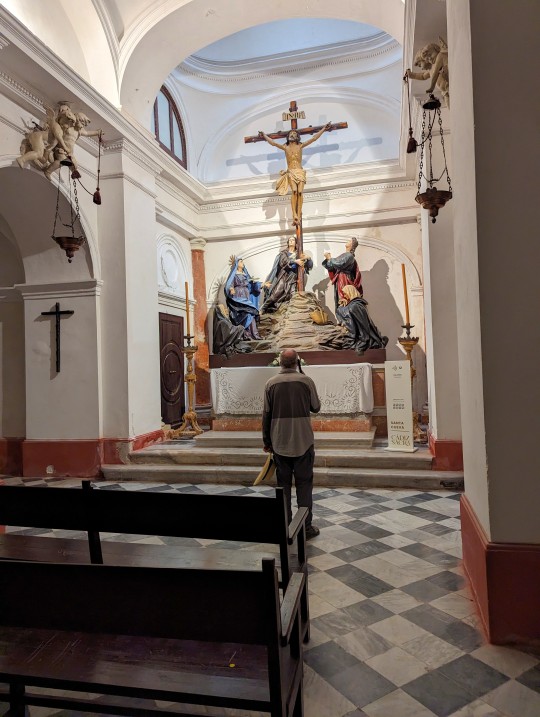
Today was filled with elaborately decorated churches and hospitals - quite amazing. We toured the Cadiz Sacra - the ticket was 9 euros a piece and included admission to Oratorio de la Santa Cueva, Hospital de Mujeres, and Oratorio de San Felipe Neri. We started at Oratorio de la Santa Cueva, the lower floor has a very small, simple chapel (pictured above). The upper level has an elaborate chapel, added later, walking into it is quite shocking after visiting the simple one on the lower level.
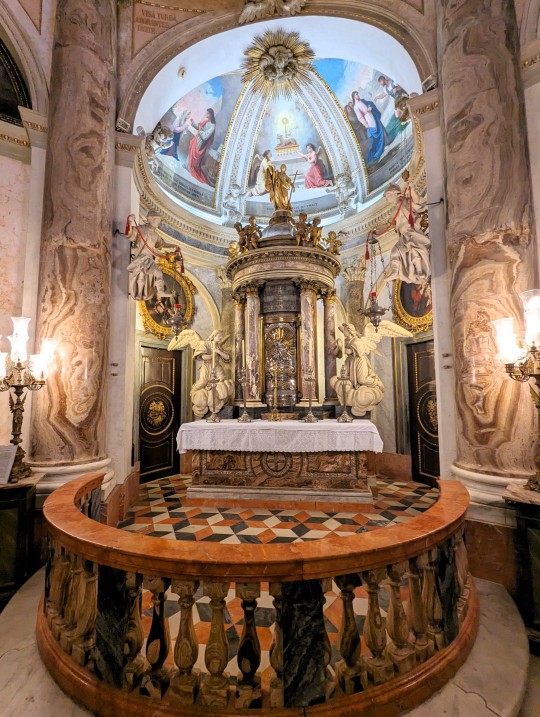
The ornate altar, look at the pattern in the marble columns - stunning! Even though the chapel was small there was a lot to take in.
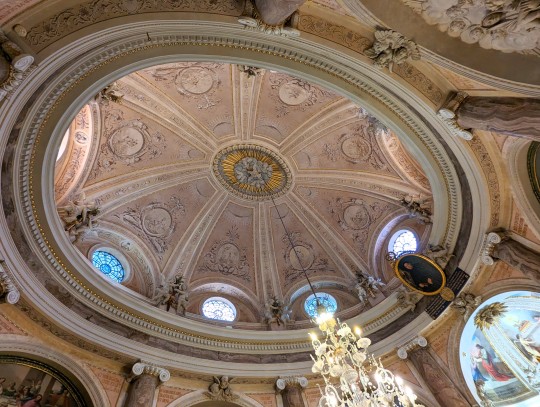
It was hard to get a picture that truly reflected the splendor of this room. Apparently, there was a mural painted by Goya in this chapel, I know that I saw it, but I didn't manage to get a photo of it.
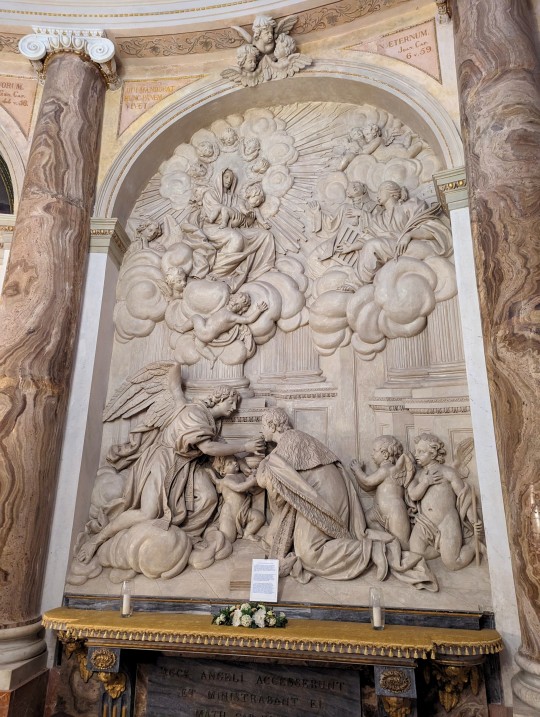
One of the sculpted scenes on the side walls of the chapel.
Next we visited Oratorio de San Felipe Neri - this temple was built in 1688. Inside the oratory are seven rectangular chapels. Each is elaborately decorated and unique, the tour included an audio guide that provided information about each of the chapels. It was a lot of information to take in - there were so many little details to be noticed in each of the chapels, I only managed to get photos of 5 of them (I must have become overwhelmed with all the info):
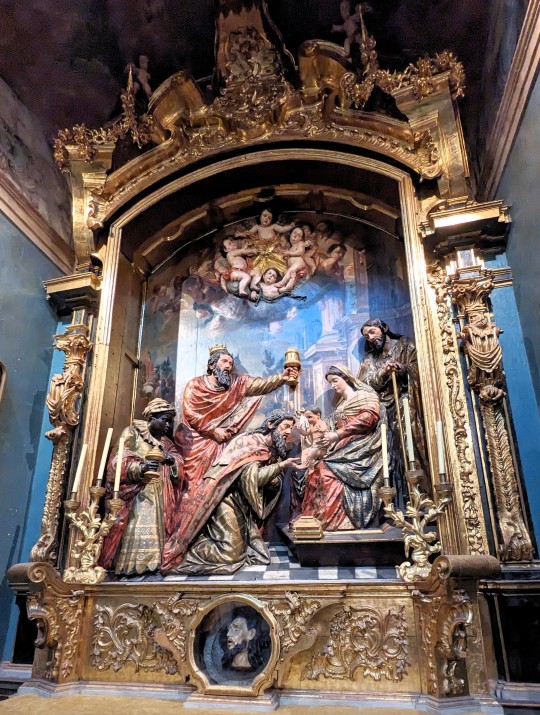
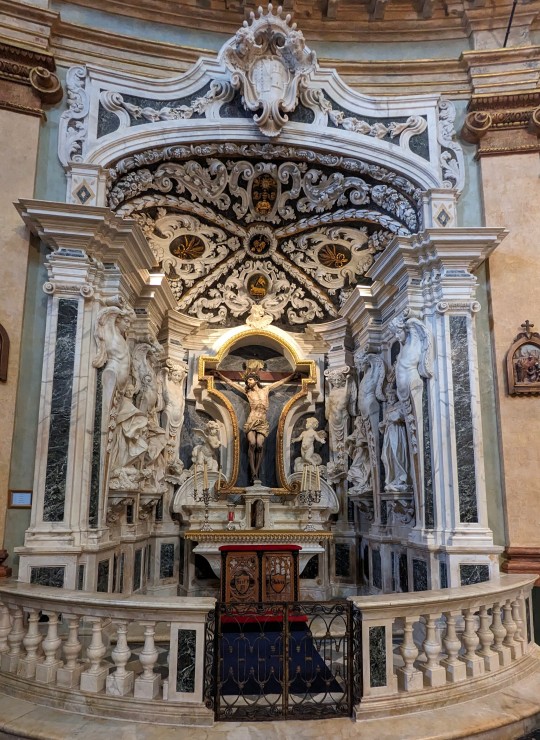
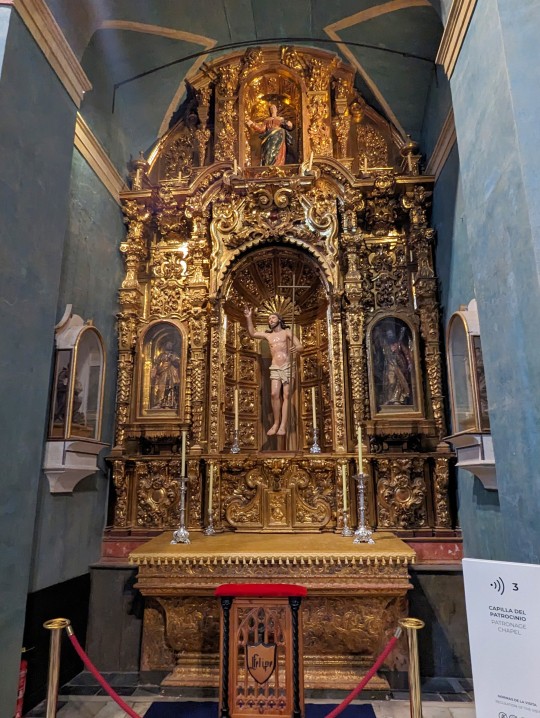


This is the largest chapel (pictured above), the painting is by Murillo and the Baroque-style design is eye-catching. We were happy that there were chairs to sit in, so that we could spend a little time in front of each of the chapels to take in the details.
Finally, we ended our tour of Cadiz Sacra at Hospital de Mujeres - unlike any hospital that we have ever stayed in.
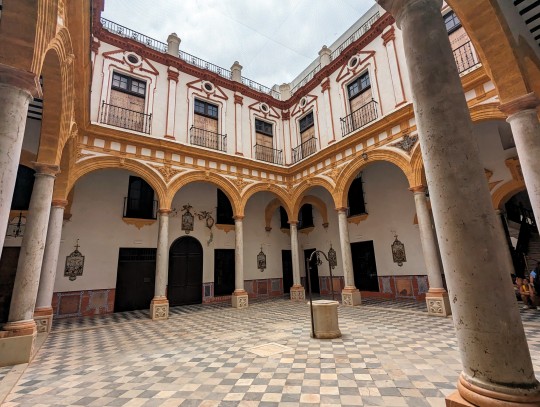
One of the beautiful courtyards at the hospital.
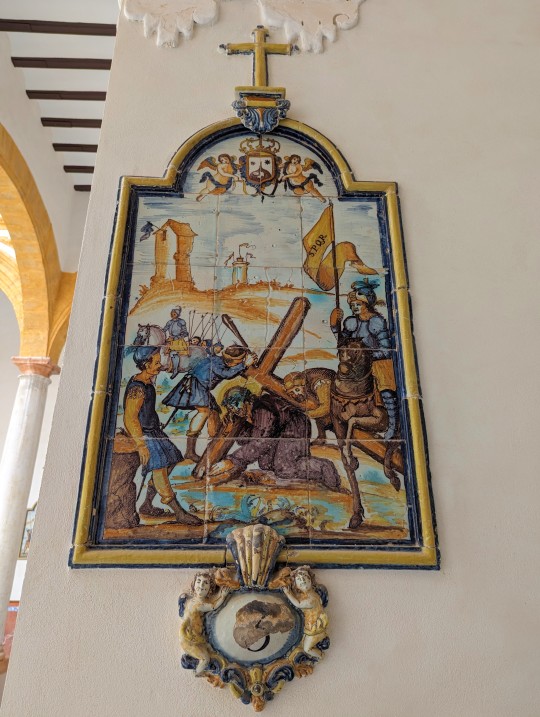
One of the tiled Stations of the Cross that line the courtyard.
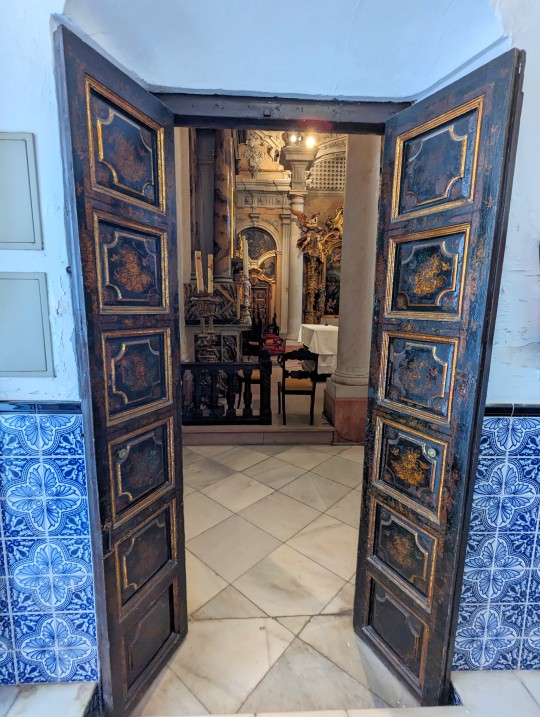
Entrance to the hospital chapel.
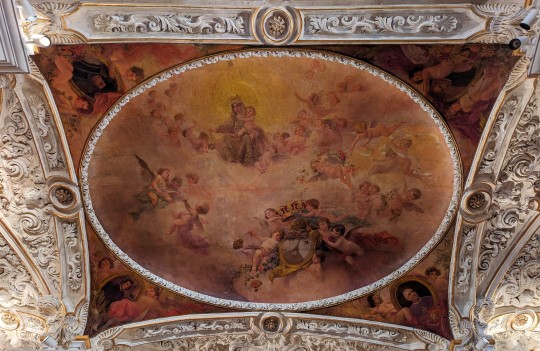
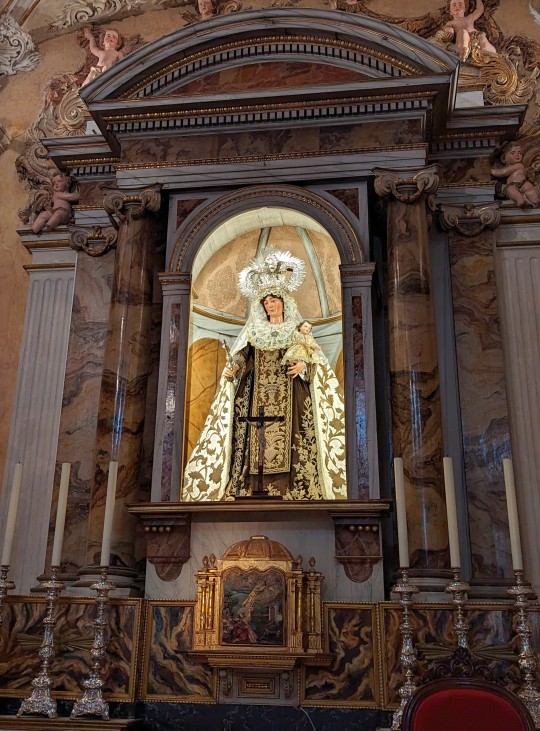
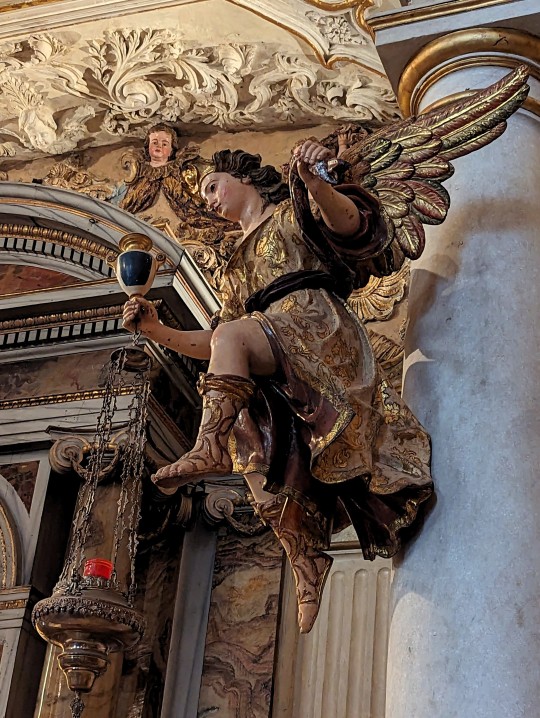
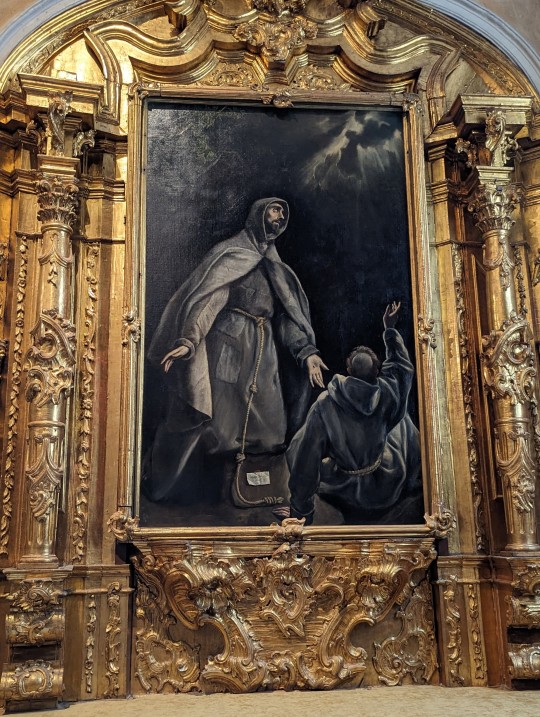
Top to bottom: the mural on the chapel ceiling, the altar, a decorative cornice, and the El Greco painting in the chapel.
We stopped and had lunch and then walked over to check out the Teatro Romano - the ruins of a Roman Theater that were uncovered in 1980. The theater was built circa 1st century B.C. and could house around 10,000 spectators.
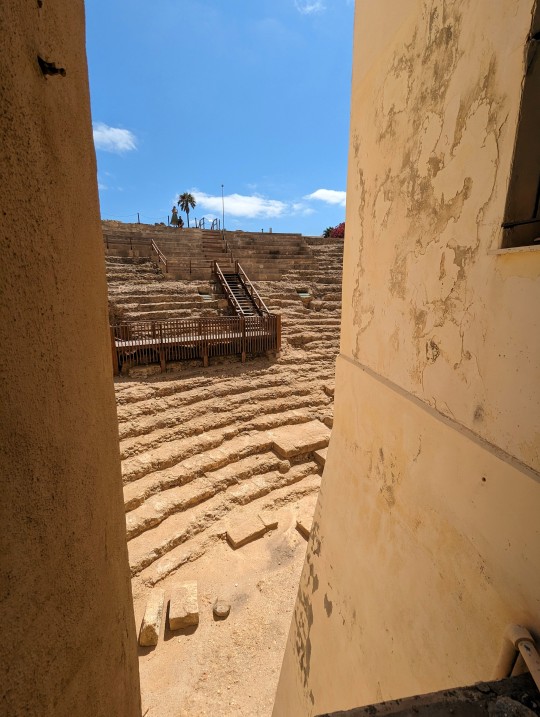
A view of the theater from the end of an alley that we accidentally turned down on our way to the theater.

The tunneled walkway that leads out to the theater.

The upper level of the theater.

The theater, tucked in and below all of the buildings that surround it.
It had been a full day, we decided to head back for a little rest - we wanted to try to go out this evening for the sunset and dinner. We passed a few interesting sights on our walk back:

Once Cadiz was no longer needed as a military stronghold, they re-purposed the cannons as protection on the corners of buildings throughout Cadiz - to prevent damage from carriages and automobiles.

One of the old city gates.

Looking back at Cadiz Cathedral from the promenade.
Cool trees in Genoves Park:



After our siesta, we wandered down to the ocean walls to watch the sunset and then find some place to enjoy a glass of wine and watch the night unfold.

Lovely sunset on our last night in Cadiz.

We had a wonderful time sitting on this plaza, we had 4 glasses of wine (it cost 8 euros TOTAL) as we watched a group of kids playing soccer (football) on the plaza until well past 11:00 at night. We stopped and picked up a pizza on our way home, Doug was hungry. As we walked out the door of the pizza place, a group of older kids were kicking a ball down the street. They were headed to the plaza, it was 11:30 and life was just starting to happen in Cadiz!
0 notes
Text

~ Wall painting fragment from the peristyle of the Villa of P. Fannius Synistor at Boscoreale.
Period: Late Republican
Date: ca. 50–40 B.C.
Culture: Roman
Medium: Fresco
#ancient#ancient art#history#museum#archeology#ancient history#archaeology#wall painting#fresco#Boscoreale#roman#ca. 50 b.c.#1st century
451 notes
·
View notes
Text

Wall painting in the imperial villa at Boscotrecase, Pompeii, Italy, last decade of the 1st century B.C. today at Metropolitan Museum of Art
Photo: Metropolitan Museum of Art / public domain
167 notes
·
View notes
Text

An Egyptian polychrome cartonnage fragment
Late Ptolemaic Period, circa 2nd-1st Century B.C.
Brightly painted in polychromy, depicting the kneeling figure of Nut with her wings outstretched
140 notes
·
View notes
Text
Hyakinthos
Hyakinthos was a Spartan prince, most prominently known in Amyclae with a decent cult following. there are a couple of different people listed as being his parents, but the most popular is King Amyclus and Diomedes. if Amyclus was his father, that would also make Daphne, another of Apollo’s lovers, Hyakinthos’s sister. it seems like he would be quite simple, he has a relatively small story with one of the earliest written records from Hesiod. in this version there is no love rival, just an accident. written in the 7th century BC, it was merely one, albeit long, sentence.
”. . ((lacuna)) rich-tressed Diomede; and she bare Hyakinthos (Hyacinthus), the blameless one and strong . . ((lacuna)) whom, on a time Phoibos (Phoebus) [Apollon] himself slew unwittingly with a ruthless disk.”
however, the most famous version, and one that most will know, comes from Ovid’s Metamorphosis. written somewhere between the 1st century BC and 1st century AD, this sentence long story grew to be paragraphs long. in which Ovid describes the love Apollo and Hyakinthos have for each other — which was the ultimate demise for the young prince. with parts of it coming from the perspective of a mourning Apollo, Ovid writes how Hyakinthos was turned into a flower with “ai, ai” written on the petals to express Apollo’s sadness. and the version that we all have come to know including betrayal and jealous rage from Zephyros (the West Wind), is hinted at in Pausanias’ “Description of Greece”.
”[In the temple of Apollon at Amyklai (Amyclae) Nikias (Nicias) [painter fl. c. 320 B.C.], son of Nikomedes, has painted him [Hyakinthos (Hyacinthus)] in the very prime of youthful beauty, hinting at the love of Apollon for Hyakinthos of which legend tells . . . As for Zephyros (the West Wind), how Apollon unintentionally killed Hyakinthos, and the story of the flower, we must be content with the legends, although perhaps they are not true history.”
despite this seemingly clear-cut story, there’s a lot more than meets the eye with Hyakinthos. according to many historians the -nth part of his name is pre-Hellenic and comes from the Mycenaean era. another word like that would be Corinth — a pre-Greek polis that was destroyed and rebuilt. this leads many to believe that Hyakinthos was around BEFORE Apollo. he would have been a chthonic vegetation god — almost like the male equivalent to Persephone. this leads to a few different theories, but before I get to that, let me tell you the story of Hyakinthos as told by Ovid and Lucian’s “Dialogues of the Gods”. ═══════════════════════════
⊰ The Myth ⊱
Hyakinthos was a beautiful Spartan prince. he had many lovers, but the one that had eventually won his heart was Apollo. the god taught beautiful long-haired Hyakinthos how to play the lyre, how to use a bow and arrows, a little bit on prophecies, and gave him a swan chariot. the two were incredibly in love, but sadly, there was someone who didn’t like that. Zephyros, the west wind, was jealous for he too loved Hyakinthos. he had tried to woo him but it really was no match for Apollo. he watched the two men play again and again until he had eventually had enough of it. he ultimately created one of the most tragic love stories. like most days, Apollo and Hyakinthos were together, playing around and having mild competitions throwing a discus. Apollo wanted to show off for Hyakinthos so he could see just what a god could do. he threw a discus high into the air, clearing the clouds away and it disappeared into the sky. Hyakinthos wanted to impress his lover as well, so he chased after the discus laughing. Zephyros in a fit of rage at the two men enjoying themselves changed the course of the discus. as it came to land, the force was so strong that it bounced off the ground and smashed into Hyakinthos’s face. Apollo ran to his lover and tried every kind of medicine and healing he could think of. he even placed ambrosia on his lover’s lips but blood flowed freely from the wound. there was no way for him to stop a wound of Fate. in his despair, he turned Hyakinthos into a flower, but seeing that wasn’t good enough, he wrote his grief upon the petals. ═══════════════════════════
⊰ Symbolism From The Myth ⊱
Taking A Temple as mentioned before, it’s very likely that Hyakinthos was an older deity from the pre-hellenic period. something that many Greek writers did, was create a myth of how a deity began their worship in a specific place. we know the temple that Apollo was worshipped at in Amyclae was older than when his worship would have started. one theory behind this myth then, is how Apollo came to be worshipped over Hyakinthos at the temple and area; by killing the previous deity. it sounds sad, but it’s actually happened several times, and even with Apollo specifically. the most famous example I can think of would be at Delphi. originally the temple was in honor of the titan Gaia. Apollo came in valiantly and killed the Python (which is what gives Apollo’s priestesses their name) and inevitably took the temple over with his worship. what this doesn’t account for, is the fact Hyakinthos is still worshipped at the temple heavily, his and Apollo’s worship having mingled and being near inseparable. it is even said that upon his death and burial, Apollo said to give him (Hyakinthos) all offerings first. now, if you know a thing or two about Greek worship, the first portion of the offering was incredibly important, especially considering hero worship was probably closer to chthonic sacrifices in practice; though they were not considered to be ‘dead’. within my research so far, I have yet to find this happening somewhere else, but I will update this if I ever do. now all of this is unusual with the theory that this myth symbolizes one deity taking over. if that were the case, why continue to worship Hyakinthos? Duality some of you may not know this about me, but I am a sucker when it comes to duality, specifically with lovers. this myth may be a symbol for the growing season and harvest of the crops. while it may be a common motif, especially among the Greeks, I think it’s a sweet and somber story giving personification to an important aspect of Greek life. I also believe the duality is less about the exacts of what they rule over, but the way they were worshipped. the closest example I can think of also comes from Delphi with the duality between Apollo and Dionysos (who, shockingly enough, was the only other god historians believe was present during the Hyakinthia festival besides Apollo and Hyakinthos). as a hero, or simply for his chthonic aspect, the ritual and practice would have been far different than that for Apollo. while this isn’t exactly backed by anything I can find specific to duality, I personally feel a reason both Apollo and Hyakinthos were worshipped together in Amyclae is due to that duality between them. Hyakinthos would have been a chthonic deity probably for vegetation or agriculture, whereas Apollo here is a god of light (not the sun) representing life, health, and the ultimate grief. their worship in Amyclae was always together once Apollo was introduced (to some this hinted that they were possibly the same person representing a cycle, but most disagree with this theory). the duality is clearly a theme already for Apollo, and I think what happened at Delphi with Dionysos is the same for Amyclae and Hyakinthos. together they represent loss and mourning but also happiness and life — love. ═══════════════════════════
⊰ Hyakinthos Associations ⊱
okay, now that I have bored you all to death, let’s talk about some less heavy things. due to their worship being completely together, I would say that nearly anything related to Apollo can also be associated with Hyakinthos and vice versa. however, we love individuality in this house, so let’s talk about the things either associated with him through the various, limited texts we have and some UPG. Associations ➳ larkspurs/hyacinths ➳ swans ➳ bow and arrow ➳ summer! ➳ new spring growth ➳ chiton’s (they were offered to him by the women of Sparta) ➳ death ➳ rebirth/cycles ➳ chariot’s ➳ blood ➳ blue/purple/red colors ➳ discus (sorry) ➳ lavender ➳ lyre ➳ lapis lazuli ➳ amethyst ➳ black tourmaline ═══════════════════════════ Devotional Activities ➳ keeping a garden ➳ maybe even an indoor garden ➳ go to parks and feed the swans/birds ➳ archery ➳ sports ➳ making a chiton ➳ writing poems ➳ taking care of those around you ➳ growing larkspurs/hyacinths ➳ get a devotional journal ➳ create a playlist (sad songs for the most part) ➳ fall in love deeply ═══════════════════════════
⊰ Deity Or Divine Hero? ⊱
I don’t know if this question can be answered for a fact honestly. what we do know is that he was at least worshipped as a hero, that much can be said. anything further than that comes at a later time and from the outside perspective. a lot of ancient Greek writers didn’t write down certain things because they saw them as common knowledge. this doesn’t help us looking back now. what we can say, is that some of the offerings given to him were not common with hero worship and would have been reserved for the gods. this is according to Angeliki Petropoulou, a professor in ancient greek studies/religion, and the author of “Hyakinthos and Apollo of Amyklai: Identities and Cults. A Reconsideration of the Written Evidence” pages 153-161. Within this, she makes the argument that Hyakinthos has gone through ‘apotheosis’. this is the action of a mortal, usually a hero, becoming a god. note: ‘βουθυσία’ is a traditional oxen sacrifice.
“The βουθυσία for Hyakinthos, which is indicative of his new immortal status, should be placed on the third day too. Oxen are costly victims, the bull being the most “noble” sacrificial animal. After mourning for Hyakinthos’s death and making a propitiatory sacrifice at his tomb, they honoured him with a bull sacrificed as if to a god. Yet the geographical range in which he was regarded as god was rather circumscribed and did not spread beyond the borders of Lakedaimonia. The βουθυσία for Hyakinthos would have been instituted after the construction of the altar on which Apollo received sacrifices; for the only altar excavated, in an area filled with remnants of burnt sacrifices, is attributed to Apollo.”
so there you have it. most places will probably call him a hero, and that wouldn’t be wrong. others may call him a deity, which also isn’t wrong. I’ll tell you what I’m personally going to go with, and everyone can make their own decision based on the information listed through this post and the readings I’ll link at the bottom. no matter your conclusion, the relationship you have will be completely yours, and it’s ok! if anything, I encourage that over taking my word for it. ══════════════════════════ for me, I think I consider him a deity. I know that I heavily romanticize the story, and with Apollo being so near to my heart, him having a terrible love life hurts my soul. while I don’t exactly want to rewrite any myths, I won’t claim that they are married, I will say that I believe them to be happy. their worship in Amyclae was so intertwined and based completely around each other from the history we know, that, for me, it makes sense to also honor them together. I’ll leave you all on one more incredibly sad quote from Lucien’s “Dialogue of the Gods” (that I referenced from earlier).
”Apollon : Well, my loves never prosper; Daphne and Hyakinthos (Hyacinthus) were my great passions; she so detested me that being turned to a tree was more attractive than I; and him I killed with a quoit. Nothing is left me of them but wreaths of their leaves and flowers.”
it’s ok to cry, I do nearly every time I read that.
⊰ For Further Reading ⊱
➳Hyakinthos theoi ➳Apollo theoi ➳Hyakinthos Wiki ➳My Hellenic Research Google Drive this also contains the Sparta book I reference and a few others worth a read.
#mine#greek#greek gods#greek mythology#greek paganism#hellenism#pagan#apollo#hyakinthos#greek pagan#theoi
121 notes
·
View notes
Photo

Rattle Bowl, Trophy-Head Deity, 3rd–1st century B.C., Metropolitan Museum of Art: Arts of Africa, Oceania, and the Americas
Gift of Nathan Cummings, 1976 Size: H. 2 × W. 6 7/8 × D. 6 7/8 in. (5.1 × 17.5 × 17.5 cm) Medium: Ceramic, post-fired paint
https://www.metmuseum.org/art/collection/search/310222
26 notes
·
View notes
Text
Mun Mermaid explains further why she loves SwissGre
Okay so i hope this won't be taken down for "hate speech". I will explain further why i love SwissGre so much. If you don't like this ship , don't bash on it, just ignore this post.
Why i ship it
The two countries have excellent historical and diplomatical relationships. Switzerland was one of the nations who supported Greece during the Revolution against Turkey in 1821 . Their relations still remain warm even nowadays and they are very close. Switzerland and Greece developed diplomatic relations after the second one's independence in 1830.
History
It may be unbeliavable but the relations between Switzerland and Greece actually began from the Ancient times. In Bern, a bronze amphora with a Greek inscription (6th century BC) is discovered. Presence of Greek vessels in Lenzburg (canton of Aargau) is suspected on the spot production by Greek craftsmen, while ancient coins with the head of Artemis are discovered in Icino.
Greek coins of the 4th century B.C. contacts Switzerland's relations with Greece and the participation of Swiss in Macedonian troops. The 2nd century B.C. stoic philosopher Posidonious of Rhodes likens the Helvetian Celts to the Gaul warriors. According to Strabo(1st century B.C.) they are described as gold-rich and peaceful.
Julius Caesar reported that the Helvetian Celts borrowed and used Greek letters for their writing.Funerary monuments bearing Greek characters are described by the Roman historian Tacitus.
Archaeological excavations in the canton of Valais brought to the light two Parian marble statues of the gods Apollo and Aphrodite which are now exhibited in the Martigny Giannda Foundation.
The Swiss city Basel is first mentioned with its Greek origin name as early as 374 A.D. (Derived from the Greek given name Basilius).
The relations of these two countries continued even in the Byzantine and medieval eras. Various objects (such as diptychs and icons) travel from church to church and monastery to monastery. Valuable information can be found in the library bearing the Greek inscription “Ψυχής Ιατρείον” (meaning “healing of the soul”), at the St. Gallen Abbey, the St. Maurice Abbey, the Sion Valère Museum, the Zurich National Museum and others. Swiss warriors and knights were known to defend various Greek regions like Rhodes, Crete, Euboa and the Peloponeso from the Turks after the fall of Constantinople. Those men were distinguished for their skills in warfare.
In Switzerland the interest for the Greek History and Culture still remained unchanged during the Renaissance era with Basel being the epicenter and the spiritual ties with the wisdom of the ancient Greek world are reinstated ever more. In particular, after the Fall of Constantinople, the Greek spiritual heritage inspires the Humanists (Erasmus) and the Protestant Reformation. The exchange of views between the Patriarch of Constantinople Cyril Loukaris (1572 - 1638) and the Geneva Academia theology Professor Antoine Léger (1596 - 1661) is illustrated in a series of manuscripts.
The remarkable contribution of Franciscus Portus, born in Rethymno, Creta, and a Calvin’s friend, is worth mentioning. He taught Greek at the then newly established Geneva Academy (1562 - 1581) and vigorously defended the modern Greek, against the Erasmian pronunciation. His work was taken over by his son, Emil.
In the field of visual arts, Swiss painters Angelica Kauffman and Johann Heinrich Füssli (alias Henry Fuseli (famous for his work Reflections On the Painting and Sculpture of the Greeks, 1765) had their role to play in the 18th century Neoclassicism movement.
Ugo Foscolo the national poet of Italy, who was born in Zakynthos was persecuted for his democratic ideas and passed into Zurich(1813-1816). In 1816 he met with his disciple Andreas Calvos, the Greek poet, and both, thanks to the assistance of Kapodistrias departed for London.
The first governor of Greece Ioannis Kapodistrias is considered as a national hero in Switzerland because he introduced the Swiss neutrality and the creation of the Swiss cantons. The governing model of this country is based on the Ancient Athenian democracy as well.
According to historical sources Kapodistrias spend two distinctive periods of his life in Switzerland : the first during the Congress of Vienna between 1813-1824 and the second one during the Greek Revolution from 1822 to 1827.
Kapodistrias decisively contributed, first as an envoy of Tsar Alexander I and then as his Ambassador, in preparing the Swiss Constitution, but also in recognizing the independence and neutrality of the Swiss Confederation (1813-1814). On 10.09.1814 he writes to his father: “... the completion of such a complicated negotiation has cost me a lot of suffering, travelling, writing and giving speeches and preparing constitutions and drafts, but it does not matter. These brilliant people (the Swiss) filled me with their friendship and wholehearted warmness. The trust they showed me was the best reward for all my sufferings. If they can be happy in the future and enjoy their independence, I will say that I didn't waste my time and my efforts.”
A year later, while attending the Vienna Congress as Minister for Foreign Affairs of the Russian Empirer for the Eastern question, Kapodistrias met with the Swiss envoy, and a friend of his, Pictet de Rochemont, who was accompanied by his nephew and benefactor of Greece, Jean Gabriel Eynard. Pictet de Rochemont, in one of his letters from Vienna to his Swiss compatriots writes:
"what can we do for Kapodistrias, this excellent person. He is the Phoenix of Democracy. Without his contribution the Vienna Congress and the rest would have been different. I am convinced that without him Switzerland would have been completely overthrown. If he ever passes from Geneva, you should ring all the bells of our churches and welcome his arrival with the thunder of our artillery. "
Upon his return to Geneva and Lausanne in 1822, the two cantons of Geneva and Vaud declared him an honorable fellow citizen. Kapodistrias remained in Switzerland until 1827, where he was working tirelessly and inspired Swiss philhellenism.
The President of the Swiss Confederation, in his speech in Sochi, Russia, on the occasion of the 2014 Winter Olympics, made an explicit tribute to the great Greek diplomat and his contribution to his country's independence and neutrality.
Many Swiss helped during the Greek Revolution in 1821 against Turkey already from its beginning. One example was Johann Jakob Meyer, doctor and owner of the first Greek newspaper. He sacraficed his life fighting the Turks in Missolonghi. He was also married to a Greek woman and became Orthodox.
The first Philhellenic Club of Europe was founded in Bern, Switzerland during the Revolution of 1821.
The Swiss banker and diplomat Jean Gabriel Eynard was a great supporter of the Greek Revolution and a benefactor of Greece. He had a close friendship with Ioannis Kapodistrias the first governor of Greece after its independence.
Switzerland was also one of the first nations to develop diplomatical relations with Greece after the second one's independence in 1830.
Inspired by the Greek civilization, Johann-Jakob Bachofen, a great philosopher and professor from Basel, visited Greece in the mid-19th century. Later, he wrote an in-depth study on the ancient funerary monuments. Jacob Burckhardt, also born in Basel, a scholar and art historian, was deeply interested in the Greek civilization (1898 - 1902). Of great interest is the correspondence between Burckhardt and his fellow Professor in Basel University, the philosopher Friedrich Nietzsche. Nietzsche spent ten years in Basel teaching ancient Greek literature and philosophy in Basel, and leaving in the city’s fertile and free-spirited academic environment, wrote his Birth of Tragedy (1872) and his Philosophy in the Tragic Age of the Greeks (1873), two major works that revolutionised the studies on classic Greek culture.
Before them travellers, scholars, architects and archaeologists (Paul Schazmann (1871-1946) and Ernst Robert Fiechter (Basel, 1875 – St. Gallen, 1948) topographers, historians (University Professor and politician Wilhelm Vischer-Bilfinger, Basel, 1833-1886), as well as landlords, and entrepreneurs, were settled in Northern Euboea, after the Independence (Koulouri, Marouli, Ayyanako, Artemisio, Geraki, Istiea). Most of them coming from well-known Bernese families: Carlo Leutwein, Karl von Müller (Emmanuel von Fellenberg's grooms), Friedrich von Fellenberg (son of Emmanuel), Rudolf von Wild together with their British friend Edward Noel, a Lord Byron’s nephew.
Botanists (Alphonse de Candolle, Henri Margot, the prominent Edmond Boissier, 19th century, Martin Rikli, and Gustave Beauverd, 20th century) meticulously documented the Greek flora.
Swiss artist and archaeological draftsman Emile Gilliéron (1850–1924) lived in Greece and is best known for his work on polychromic Minoan and Mycenaean artifacts and produced copies. Henri-Max Imhof from Uri, appointed as professor at the Art Academy in Athens, where he also dealt with the restoration of excavated antiquities and the caryatids of the Erechtheion, the painter Jean Leu, Jean-Jacques Wolfensberger from Rümlikon, Frank Buchser from Solothurn and the famous Arnold Böcklin from Basel (his well-known painting "Isle of the Dead" is inspired by the islet of Pontikonisi near Corfu). Later, the painter Otto Haberer-Sinner was inspired by Greek themes (wall-paintings at the Bellevue Bern Hotel, 1913).
Moreover, the unique panoramic work of the Swiss painter Edward Castres (1881) in Lucerne, depicting the overwhelmed French army, under the command of the French general, and Greek descend, Charles Denis Sauter Bourbaki, who took refuge in Switzerland (1871) persecuted by the Prussians. The crossing of Switzerland by the exhausted soldiers is today also depicted in a panorama in the city of Verrières / Parcour Bourbaki). Charles Bourbaki was the son of the legendary 1821 Revolution fighter, Colonel Constantin Denis Bourbaki, who heroically fell in the murderous battle of Kamatero (January 1827). In 1862 his name figured as candidate for the Greek Crown, but he declined the offer. The Bourbaki family from Sfakia, Crete, has excelled in the French army and holds a prominent position in the Pantheon of the Philhellenes.
Archaeologists as well as photographers arrived in Greece in the early 20th century. The first Swiss archaeologist to join the French School (1902-1903) was Georges Nicole from Geneva, and was followed by Waldemar Deonna (in Delos), Olivier Reverdin and Christiane Dunant. Alos worth mentioning is the contribution made by the Swiss Paul Collart, who participated in the French Archaeological School’s excavations, in Philippi.
The contribution of the great photographer Frédéric Boissonas was remarkable. Together with his friend Daniel Beaud-Bovy, a writer and director in the Geneva School of Fine Arts, frequently visited Greece and uniquely immortalized the Greek landscape at the beginning of the 20th century, 1903 - 1935 (see related collectibles, 1910, 1919 & 1932). Beaud-Bovy's grandson, Manuel, donated to the Photography Museum of Thessaloniki a complete archive of 13,000 photographic items, letters and publications from their voyages to Greece. The rest of the Swiss photographer's archive was recently purchased by the municipality of Geneva.
Always worth mentioning is the work of Professor in geology Charles Renz, (first half of the 20th century). Besides, the Swiss were also the first to explore Mount Olympus (alpinist Marcel Kurz from Neuchâtel, 1921).
At the beginning of the 20th century, Professor of Philosophy and Sociology Avrotelis Eleftheropoulos (1869-1963) taught at Zurich University. Always in Zurich, where statues of Ganymede and Hercules can be seen in public places, an Association is founded in 1875 by the numerous Greek community living there. In Athens they became known as the "Zurich Circle", and pioneered in the foundation of the Association of Greek Industrialists (1907). Nikos Kazantzakis visited the Alps in 1917 - 1918 (Zurich, Lugano, etc.) and returned there in 1955 to start writing his Report to Greco (Cademario, Ticino).
Also remarkable remains the contribution of the Swiss Red Cross to Greece after the 1922 disaster in Asia Minor, as well as during the 1942 - 1944 occupation (a tribute to Bertha Graf's contribution to Delphi) and the years that followed (until the beginning of 1960’s). Less known (and therefore needs to be highlighted) is that many Greek refuges departed for Switzerland after the Minor Asia catastrophe in 1922 and many wounded Greeks soldiers were treated in Swiss hospitals and sanatoriums.
Eleftherios Venizelos arrived in Lausanne in November 1922 and participated, as a representative of Greece, in the Lausanne Conference which began on 20 November 1922 at the Beau Rivage Hotel and led to the Lausanne Treaty signed in July of the following year. The Greek figurehead praised and admired the Alpine country, as shown in one of his speeches, after his return to Greece, on October 12, 1930, to the Greek youth: “Imagine, gentlemen, that Switzerland, which is today at the forefront of European civilization, imagine her as a nation despised by all, and deprived from ideals! (as if he wanted to contradict G. Theotokas). I only wish you were there on August 1st, on the Swiss National Day, to see with what pride the Swiss soul stands for the Swiss nationality ...’’ Excerpt from the book Eleftherios Venizelos and his turbulent era by Pavlos N. Tzermias.
Modern times
In the modern times the two nations of Switzerland and Greece are still close and the relationships remain excellent.There are 48 Swiss companies in Greece that employ about 10,000 people. The two countries have a number of treaties mainly dealing with commerce and the Social Security. The two countries made an agreement about the avoidance of the double taxation in respect of the incoming tax.
In Eretria , a region near Athens the Swiss Archaeological School is still active nowadays. Lots of Swiss tourists choose Greece and especially Greek islands as a destination for their summer vacation.
Around 11,000 Greeks live in Switzerland , with about 7,000 of them living in Zurich. Most major Swiss cities have a Greek association or community and the Greek diaspora is very active in these places. There are also around 2.921 Swiss living in Greece.
Greece has an embassy in Bern, a general consulate in Geneva and two honorary consulates in Zurich and Lugano.
Switzerland has an embassy in Athens and four consulates in Thessaloniki, Corfu, Patras and Rhodes
#aph switzerland#nyo greece#aph greece#nyo switzerland#swissgre#otp#husbandos#waifus#mermaid speaks#please respect my opinions as long as i respect yours
21 notes
·
View notes
Photo









Mamallapur in the photographs of Viktor Viktorovitch Goloubev -
Ajanta caves : the first Buddhist cave monuments at Ajanta date from the 2nd and 1st centuries B.C. During the Gupta period (5th and 6th centuries A.D.), many more richly decorated caves were added to the original group. The paintings and sculptures of Ajanta, considered masterpieces of Buddhist religious art, have had a considerable artistic influence.
En octobre 1910, Goloubev, accompagné de l'écrivain Charles Müller et d'autres amis, partit en expédition en Inde, où il étudia le complexe monastique d'Ajantâ.
cf : Charles Müller, Cinq mois aux Indes. De Bombay à Colombo, Paris, 1924
#Viktor Viktorovitch Goloubev#ajanta caves#india#1910#École des langues orientales#aurangabad#maharashtra
249 notes
·
View notes